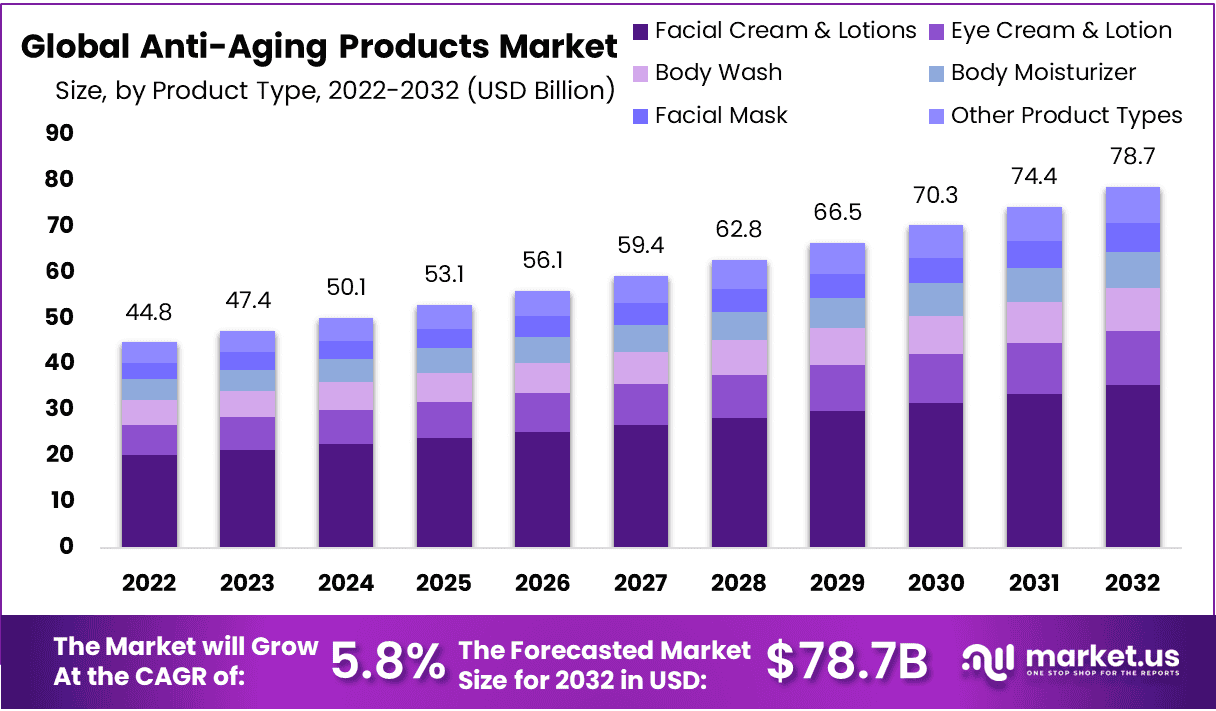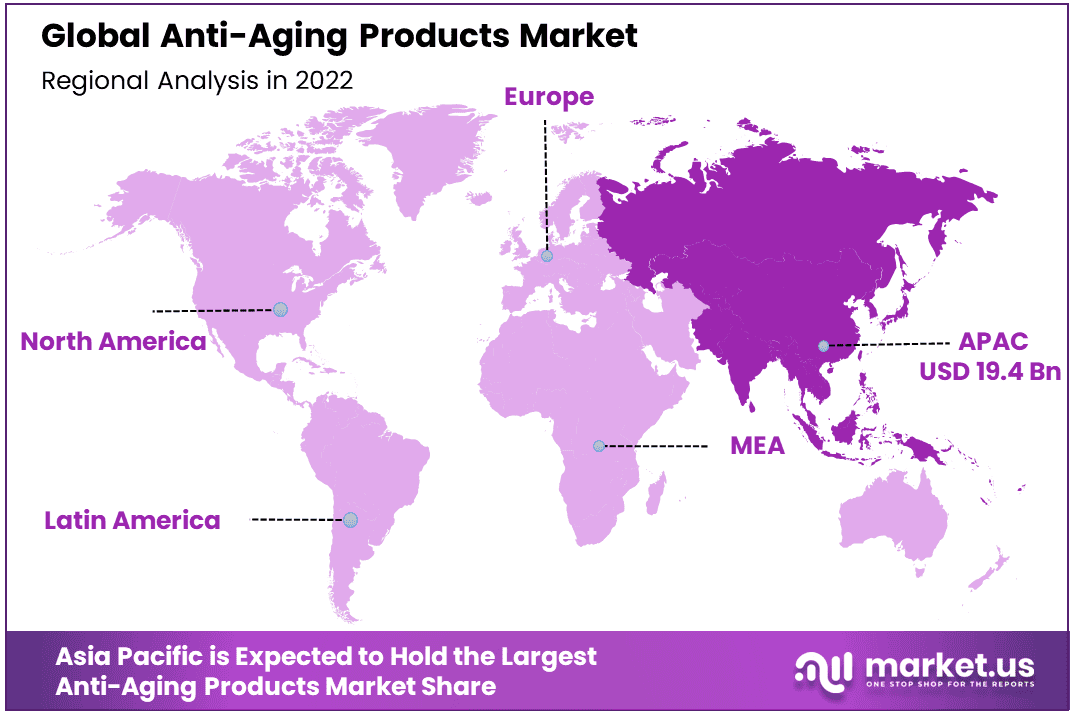Table of Contents
Introduction
Global Anti-Aging Products Market is projected to reach approximately USD 78.70 billion by 2032, up from USD 47.4 billion in 2023. This reflects a compound annual growth rate (CAGR) of 5.8% over the forecast period from 2023 to 2032.
The anti-aging products market encompasses a diverse range of products aimed at mitigating the effects of aging on the skin, thereby enhancing appearance and skin health. These products include skincare items such as creams, serums, and masks, which contain active ingredients designed to reduce wrinkles, fine lines, and other signs of aging.
The growth of this market can be attributed to several factors, including an aging global population and increasing consumer awareness about the benefits of proactive skincare regimes. Moreover, technological advancements in dermatology, coupled with the rise in disposable income across various regions, have further propelled the demand for these products.
Consumers are increasingly seeking solutions that promise not only to conceal but also to reverse the signs of aging, which has spurred continuous innovation and expansion in the product offerings within this sector. This market also presents significant opportunities for players in the

Key Takeaways
- Global anti-aging products market analysis indicate a robust growth trajectory. The market is anticipated to expand from USD 47.4 billion in 2023 to USD 78.7 billion by 2032, registering a compound annual growth rate (CAGR) of 5.8%.
- Facial Creams & Lotions are leading the product segment, accounting for over 45% of the market share in 2022, due to their effectiveness in diminishing wrinkles and enhancing skin elasticity.
- Retinol stands out in the ingredient segment, holding over 35% of the market share, recognized for its capacity to refine skin texture and augment collagen production.
- Anti-Wrinkle Treatment has captured more than 27% of the market, propelled by escalating consumer preference for non-invasive and advanced wrinkle reduction solutions.
- Offline Channels remain the predominant distribution channel, comprising over 57% of the market share, with specialty stores and supermarkets providing accessible and personalized customer service.
- Asia Pacific is the leading market, commanding a 43.5% share, driven by strong consumer demand for premium skincare products and a cultural focus on maintaining a youthful appearance.
Report Scope
| Report Features | Description |
|---|---|
| Market Value (2023) | US$ 47.4 Billion |
| Forecast Revenue (2032) | US$ 78.7 Billion |
| CAGR (2023-2032) | 5.8% |
| Segments Covered | By Product Type: Body Wash, Body Moisturizer, Eye Cream & Lotion, Facial Cream and lotions, Facial Mask, and Other Product Types; By Ingredient: Retinol, Vitamin C, Hyaluronic Acid, Alpha Hydroxy Acids, Collagen, and Other Ingredients; By Distribution Channel: Offline and Online; By End-User: Men and Women. |
| Competitive Landscape | Procter & Gamble, Johnson & Johnson, Unilever, Shiseido, L’Oréal Paris, Estée Lauder, Beiersdorf, Coty Inc., Allergan, Valeant Pharmaceuticals, Merz Group, Galderma, Nu Skin Enterprises, Mary Kay, Avon Products, Herbalife Nutrition, Amway, Forever Living Products, Natura Cosméticos, LVMH Moët Hennessy Louis Vuitton, and other key players |
Emerging Trends
- Natural and Organic Ingredients: The demand for natural and organic components in anti-aging products is rising. Consumers are increasingly aware of the ingredients in their skincare products and prefer those with natural formulations.
- Technological Integration: Advanced technologies are being incorporated into anti-aging products, enhancing their effectiveness. This includes developments in biotechnology and the use of precision medicine approaches.
- Multifunctional Products: There is a growing trend towards multifunctional skincare products that offer multiple benefits, such as anti-wrinkle combined with moisturizing properties, in a single product.
- Personalized Skincare: Customization and personalized skincare regimes are becoming more popular as consumers seek products tailored specifically to their skin’s needs.
- Increased R&D and Innovation: Significant investments in research and development are driving the launch of innovative and more effective anti-aging products.
Top Use Cases
- Skin Rejuvenation: Products aimed at reducing wrinkles, fine lines, and improving skin elasticity and texture are predominant.
- Sun Damage Repair: Products that address photoaging caused by UV exposure are critical in preventing and repairing skin damage.
- Moisturizing and Hydration: Intensive moisturizers that help in maintaining skin hydration and barrier function are popular among aging demographics.
- Pigmentation Correction: Products that help in reducing age spots and hyperpigmentation are widely used.
- Firming and Lifting: Creams and serums that claim to firm and lift the skin are increasingly popular as they offer visible improvements in skin appearance.
Major Challenges
- Regulatory Challenges: Ensuring compliance with the diverse and ever-changing global regulatory landscape remains a significant challenge.
- High R&D Costs: The high costs associated with research and development can be a barrier to entry for smaller companies and impact pricing.
- Market Saturation: With many products in the market, differentiation becomes challenging, and consumers may feel overwhelmed by choices.
- Consumer Skepticism: Skepticism about the effectiveness of anti-aging products can affect consumer trust and sales.
- Ethical Concerns: The use of certain technologies or ingredients can raise ethical questions, impacting brand image and consumer loyalty.
Top Opportunities
- Expansion in Emerging Markets: Increasing disposable incomes and growing awareness about anti-aging products in regions like Asia-Pacific provide new growth opportunities.
- Innovations in Product Delivery Systems: Developing new methods of delivery that enhance the absorption and effectiveness of anti-aging ingredients is seen as a key opportunity for growth.
- Partnerships with Dermatologists: Collaborations with healthcare professionals can enhance product credibility and consumer confidence.
- Targeted Solutions for Men: The male grooming market is expanding, including demand for anti-aging products specifically designed for men.
- Digital Engagement and E-commerce: Strengthening online presence and digital marketing strategies to reach a broader audience is crucial, especially in leveraging e-commerce platforms.
Key Player Analysis
In the global anti-aging products market for 2024, key players such as Procter & Gamble, Johnson & Johnson, and L’Oréal Paris are anticipated to maintain their leadership positions through continuous innovation and strong brand loyalty. Companies like Shiseido and Estée Lauder are expected to leverage their extensive research and development capabilities to introduce groundbreaking products that promise enhanced efficacy.
Meanwhile, brands like Unilever and Beiersdorf are focusing on expanding their product lines to include natural and organic ingredients, responding to the growing consumer demand for sustainable and environmentally friendly products. Additionally, smaller players such as Nu Skin Enterprises and Mary Kay are likely to differentiate themselves through direct selling models that offer personalized customer experiences.
Another notable trend is the strategic mergers and acquisitions by companies like LVMH and Natura Cosméticos, aiming to broaden their market reach and strengthen their portfolios. This competitive landscape is driven by a robust emphasis on technological advancements in product formulations and marketing strategies that appeal to a diverse consumer base seeking effective anti-aging solutions.
Top Key Players in the Market
- Procter & Gamble
- Johnson & Johnson
- Unilever
- Shiseido
- L’Oréal Paris
- Estée Lauder
- Beiersdorf
- Coty Inc.
- Allergan
- Valeant Pharmaceuticals
- Merz Group
- Galderma
- Nu Skin Enterprises
- Mary Kay
- Avon Products
- Herbalife Nutrition
- Amway
- Forever Living Products
- Natura Cosméticos
- LVMH Moët Hennessy Louis Vuitton
- Other Key Players
Regional Analysis
Asia Pacific Leads Anti-Aging Products Market with Largest Market Share of 43.5%
The Asia Pacific region is projected to dominate the global anti-aging products market in 2024, holding the largest market share of 43.5% and a market value estimated at USD 19.4 billion. This leadership can be attributed to a confluence of socio-economic and demographic factors, including a substantial aging population, heightened beauty and personal care awareness, and increasing consumer spending power in countries like China, Japan, and South Korea.
The region’s robust market growth is further fueled by cultural influences that place a high value on youthful appearances and skin care rituals, which have been deeply ingrained across generations. Moreover, local companies in the Asia Pacific are scaling up their operations and investing heavily in research and development to innovate and cater to region-specific consumer preferences, which often favor whitening and anti-wrinkle products.
Additionally, the expansion of distribution channels such as online retailing platforms in the region has made high-quality, premium anti-aging products more accessible to a broader audience, thus driving the market’s growth. The combination of these factors makes Asia Pacific not only a leader in market share but also a critical driver of trends and product developments in the global anti-aging products landscape.

Recent Developments
- In 2023, Dior, in collaboration with the French company Lucibel, launched an innovative LED anti-ageing mask named Dior Skin Light. This partnership, which began in July 2022, brings to market a high-tech skincare solution designed to combat signs of ageing. The mask was first introduced at the Dior Cheval Blanc spa in Paris and carries a price tag of 4,000 euros. It is now available for purchase on Dior’s website and can also be found in select spas and Dior boutiques across Paris, London, Geneva, and Oslo.
- In 2023, Boots introduced its No7 Future Renew collection, which includes a skincare range developed with an AI-engineered ‘super peptide’ known as Pepticology. This peptide blend is designed to activate the skin’s natural healing processes and rejuvenate more than 50 essential proteins within skin cells, effectively reversing multiple signs of skin damage.
- In 2023, Estée Lauder announced its new initiative called Skin Longevity, which focuses on pioneering research into skin health and longevity. The initiative, grounded in 15 years of research, features new product developments that utilize cutting-edge technology to reverse ageing signs, reinforcing Estée Lauder’s leadership in science-driven luxury skincare.
- In April 22, 2024, Beiersdorf made a significant scientific advancement by identifying a new active ingredient that addresses the skin’s glycation process, a condition exacerbated by excessive sugar consumption that leads to ageing and wrinkle formation. This breakthrough was achieved after nearly a decade of research, emphasizing the lesser-known impact of sugar on skin health and ageing.
Conclusion
The global anti-aging products market is poised for substantial growth, driven by a combination of demographic shifts, advancements in skincare technology, and evolving consumer preferences. As populations age and awareness of skin health increases, the demand for products that not only prevent but also reverse the signs of aging continues to rise. This market is further supported by innovations in product development and a shift towards natural and organic ingredients, catering to consumers’ increasing demands for sustainable and effective solutions. Strategic collaborations and digital marketing strategies are crucial for reaching a wider audience and sustaining growth in a competitive landscape. With its significant expansion potential, the anti-aging products sector remains a dynamic and lucrative market for existing players and new entrants alike.
Discuss Your Needs With Our Analyst
Please share your requirements with more details so our analyst can check if they can solve your problem(s)





